Navigation
Subseafloor Observatories Installed to Run Dynamic Experiments
Marine geologists have returned from two months at sea off British Columbia, Canada, where they installed two observatories in the ocean foor to run innovative experiments at the bottom of the sea.
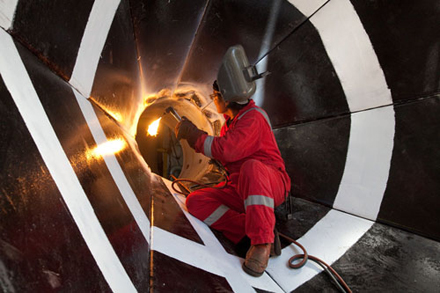 |
| A welder works on a "reentry cone" used to guide drill pipe into the ocean floor. Photograph courtesy of IODP |
Marine geologists have returned from two months at sea off British Columbia, Canada, where they installed two observatories in the ocean foor to run innovative experiments at the bottom of the sea.
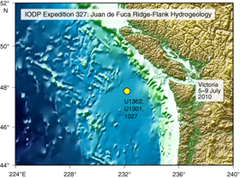 |
| IODP Expedition 327 installed undersea observatories in the Pacific Ocean off Canada. Photograph courtesy of IODP |
The Integrated Ocean Drilling Program (IODP) "Juan de Fuca Ridge-Flank Hydrogeology" expedition--Expedition 327--left Victoria, Canada, on July 9th and returned on September 5th.
The IODP is an international research program dedicated to advancing scientific understanding of the Earth through drilling, coring, and monitoring the subseafloor.
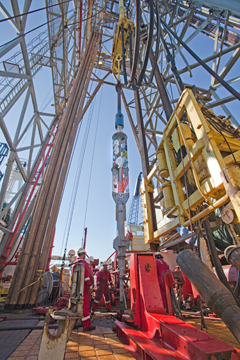 |
| One of the CORKs on the rig floor of the JOIDES Resolution, ready to be deployed. Photograph courtesy of IODP |
Using the scientific research vessel JOIDES Resolution, the team drilled boreholes 530 meters deep (nearly 1,800 feet) into the ocean floor to install the observatories. The JOIDES Resolution is a scientific research vessel managed by the U.S. Implementing Organization of IODP (USIO).
"The ocean crust is the largest aquifer on the planet," says expedition co-chief scientist Andy Fisher of the University of California at Santa Cruz. "We know it's made up of many sections, but we have no idea how these parts connect or how they interact with one another. The observatories will help us find answers."
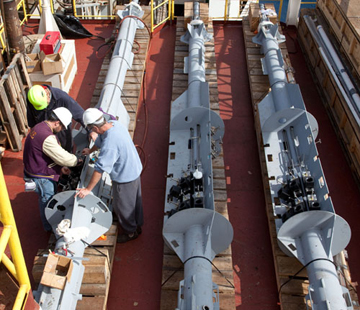 |
| Bob Aduddell, Samuel Hulme and Geoff Wheat work on deck to prepare a CORK observatory. Photograph courtesy of IODP |
These observatories, known as "CORKs" (because they are used to seal boreholes), were installed 200 kilometers (125 miles) west of Vancouver Island, Canada.
Each CORK is packed with scientific instruments that collect samples and data at multiple depths to learn more about the water, pressures, temperatures, chemistry, and microbiology within the rocks and sediments of the ocean crust.
"Expedition 327 has completed some of the most complex borehole observatory installations ever attempted," says Jamie Allan, program director in the National Science Foundation's (NSF) Division of Ocean Sciences, which funds IODP.
"These observatories will measure directly, within the oceanic crust, key characteristics that govern an unseen, remote, yet geographically widespread biological world, and will support long-term chemical and biological sampling and environmental monitoring of this exotic habitat."
The CORKs are being used as part of a sampling and monitoring network to allow scientists to determine the properties of the ocean crust, and to better understand how water, heat, and chemicals are transported across vast distances below the bottom of the ocean.
The volume of salt water in the ocean crust is comparable to the volume of fresh water in Earth's ice caps and glaciers - about 20-30 million cubic kilometers.
For comparison, this is about 2,000 times greater than the global fresh water supply, and about a half million times greater than annual fresh water usage in the U.S.
Like fresh water on land, the salt water below the seafloor is in motion, moving rapidly from place to place.
Until now, scientists have never been able to "tag" water in one place below the seafloor and determine where it flows.
Experiments begun during the expedition will provide the first direct evidence of active flow pathways and rates in the ocean crust.
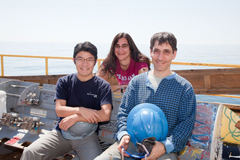 |
| Co-chief scientists Takeshi Tsuji and Andy Fisher, with expedition manager Katerina Petronotis. Photograph courtesy of IODP |
Researchers used the boreholes to run experiments during the expedition. In one experiment, they injected benign tracers into the ocean floor to track the directions, rates, and patterns of fluid flow within the seafloor.
In another experiment, microbiologists placed chips of rocks and minerals in the CORKs to identify microorganisms living in the seafloor.
"It's like lowering an empty hotel into the borehole," explained co-chief scientist Takeshi Tsuji of Kyoto University, Japan. "When the chips are recovered in a few years, we will learn who moved in."
Scientists estimate that a large fraction of life on Earth thrives in the "subsurface biosphere."
Once identified, the microorganisms from the CORKs will be matched to pressure and temperature data to determine the physical conditions that are most favorable to life at different depths.
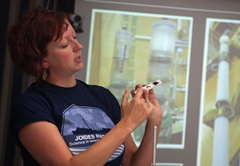 |
| Beth Orcutt discusses CORK microbiology experiments with colleagues during the expedition. Photograph courtesy of IODP |
Fisher and his team will recover CORK samples and data and run additional experiments next summer and in later years.
"Through monitoring and experiments with CORKS, we will learn how microorganisms may have developed on Earth, which offers insight into how life may develop on other planets," he says.
"We'll also learn how carbon is transported and might be stored within deep reservoirs."
"Beyond the successes of this expedition," says Rodey Batiza, marine geology and geophysics section head in NSF's Division of Ocean Sciences, "the upcoming ACORK (Advanced Circulation Obviation Retrofit Kit) expedition will instrument the sea-floor with very sophisticated instrumentation to conduct experiments."
"The results will be relayed in real time via cables as part of the Neptune Canada Observatory Network, showing the great scientific overlap between ocean observing and scientific ocean drilling."
Three educators, an engineering student, a computer graphics animator, and an artist from the U.S. and France joined Expedition 327 to develop tools to share the expedition's goals with non-academic audiences.
Next IODP Expedition Will Install CORK off Vancouver Island, Canada
The JOIDES Resolution embarks on its next expedition on September 9th, 2010. Led by Earl Davis of Canada's Pacific Geoscience Center, the "Cascadia ACORK" expedition will install a new CORK observatory in the Cascadia subduction zone, about 75 kilometers off the coast of Vancouver Island. The CORK will monitor changes in pressure associated with this seismically active setting, and help scientists understand the formation of gas hydrates--ice-like deposits of gas commonly found below the ocean floor.
In a year, the new CORK will be connected to the NEPTUNE-Canada deep-ocean cable network, which will provide power and real-time data collection over the coming decades. An onboard education program, "School of Rock," will teach 20 educators about marine geoscience. Davis and colleagues will return to Victoria on September 19, 2010.
Notes About IODP:
Together, Texas A&M University, Lamont-Doherty Earth Observatory of Columbia University, and the Consortium for Ocean Leadership comprise the U.S. Implementing Organization of IODP (USIO). IODP is supported by two lead agencies: the U.S. National Science Foundation (NSF) and Japan's Ministry of Education, Culture, Sports, Science, and Technology.
Additional program support comes from the European Consortium for Ocean Research Drilling (ECORD), the Australian-New Zealand IODP Consortium (ANZIC), India's Ministry of Earth Sciences, the People's Republic of China (Ministry of Science and Technology), and the Korea Institute of Geoscience and Mineral Resources.
This news is from the National Science Foundation (NSF) September 7, 2010
Search
Latest articles
Agriculture
- World Water Week: Healthy ecosystems essential to human health: from coronavirus to malnutrition Online session Wednesday 24 August 17:00-18:20
- World Water Week: Healthy ecosystems essential to human health: from coronavirus to malnutrition Online session Wednesday 24 August 17:00-18:20
Air Pollution
- "Water and Sanitation-Related Diseases and the Changing Environment: Challenges, Interventions, and Preventive Measures" Volume 2 Is Now Available
- Global Innovation Exchange Co-Created by Horizon International, USAID, Bill and Melinda Gates Foundation and Others
Biodiversity
- World Water Week: Healthy ecosystems essential to human health: from coronavirus to malnutrition Online session Wednesday 24 August 17:00-18:20
- Mangrove Action Project Collaborates to Restore and Preserve Mangrove Ecosystems
Desertification
- World Water Week: Healthy ecosystems essential to human health: from coronavirus to malnutrition Online session Wednesday 24 August 17:00-18:20
- UN Food Systems Summit Receives Over 1,200 Ideas to Help Meet Sustainable Development Goals
Endangered Species
- Mangrove Action Project Collaborates to Restore and Preserve Mangrove Ecosystems
- Coral Research in Palau offers a “Glimmer of Hope”
Energy
- Global Innovation Exchange Co-Created by Horizon International, USAID, Bill and Melinda Gates Foundation and Others
- Wildlife Preservation in Southeast Nova Scotia
Exhibits
- Global Innovation Exchange Co-Created by Horizon International, USAID, Bill and Melinda Gates Foundation and Others
- Coral Reefs
Forests
- NASA Satellites Reveal Major Shifts in Global Freshwater Updated June 2020
- Global Innovation Exchange Co-Created by Horizon International, USAID, Bill and Melinda Gates Foundation and Others
Global Climate Change
- World Water Week: Healthy ecosystems essential to human health: from coronavirus to malnutrition Online session Wednesday 24 August 17:00-18:20
- Mangrove Action Project Collaborates to Restore and Preserve Mangrove Ecosystems
Global Health
- World Water Week: Healthy ecosystems essential to human health: from coronavirus to malnutrition Online session Wednesday 24 August 17:00-18:20
- More than 400 schoolgirls, family and teachers rescued from Afghanistan by small coalition
Industry
- "Water and Sanitation-Related Diseases and the Changing Environment: Challenges, Interventions, and Preventive Measures" Volume 2 Is Now Available
- Global Innovation Exchange Co-Created by Horizon International, USAID, Bill and Melinda Gates Foundation and Others
Natural Disaster Relief
- STOP ATTACKS ON HEALTH CARE IN UKRAINE
- Global Innovation Exchange Co-Created by Horizon International, USAID, Bill and Melinda Gates Foundation and Others
News and Special Reports
- World Water Week: Healthy ecosystems essential to human health: from coronavirus to malnutrition Online session Wednesday 24 August 17:00-18:20
- STOP ATTACKS ON HEALTH CARE IN UKRAINE
Oceans, Coral Reefs
- World Water Week: Healthy ecosystems essential to human health: from coronavirus to malnutrition Online session Wednesday 24 August 17:00-18:20
- Mangrove Action Project Collaborates to Restore and Preserve Mangrove Ecosystems
Pollution
- Zakaria Ouedraogo of Burkina Faso Produces Film “Nzoue Fiyen: Water Not Drinkable”
- "Water and Sanitation-Related Diseases and the Changing Environment: Challenges, Interventions, and Preventive Measures" Volume 2 Is Now Available
Population
- "Water and Sanitation-Related Diseases and the Changing Environment: Challenges, Interventions, and Preventive Measures" Volume 2 Is Now Available
- "Water and Sanitation-Related Diseases and the Changing Environment: Challenges, Interventions, and Preventive Measures" Volume 2 Is Now Available
Public Health
- Honouring the visionary behind India’s sanitation revolution
- Honouring the visionary behind India’s sanitation revolution
Rivers
- World Water Week: Healthy ecosystems essential to human health: from coronavirus to malnutrition Online session Wednesday 24 August 17:00-18:20
- Mangrove Action Project Collaborates to Restore and Preserve Mangrove Ecosystems
Sanitation
- Honouring the visionary behind India’s sanitation revolution
- Honouring the visionary behind India’s sanitation revolution
Toxic Chemicals
- "Water and Sanitation-Related Diseases and the Changing Environment: Challenges, Interventions, and Preventive Measures" Volume 2 Is Now Available
- Actions to Prevent Polluted Drinking Water in the United States
Transportation
- "Water and Sanitation-Related Diseases and the Changing Environment: Challenges, Interventions, and Preventive Measures" Volume 2 Is Now Available
- Urbanization Provides Opportunities for Transition to a Green Economy, Says New Report
Waste Management
- Honouring the visionary behind India’s sanitation revolution
- Honouring the visionary behind India’s sanitation revolution
Water
- Honouring the visionary behind India’s sanitation revolution
- Honouring the visionary behind India’s sanitation revolution
Water and Sanitation
- Honouring the visionary behind India’s sanitation revolution
- Honouring the visionary behind India’s sanitation revolution

